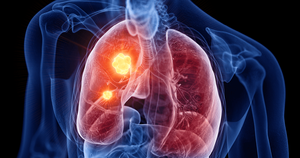Pathogenesis and Pathophysiology
Lung Cancer Development and Progression
Like all forms of cancer, lung cancer is defined by uncontrolled cell division caused by loss of physiological tissue homeostasis and failure of apoptotic cell death mechanisms. Aberrant cell proliferation turns into malignancy when the cell mass invades neighboring tissues; after this step, the cancer may metastasize to distant tissues and organs. To survive, a tumor must also promote neoangiogenesis (to supply its growing mass with nutrients) and evade the immune system. These changes arise because of mutations in previously healthy cells, whether point mutations (which affect a single nucleotide) or structural mutations which affect larger DNA segments (e.g., duplications, insertions/deletions, rearrangements). Duplications are commonly observed in cancers; both copy number variations (e.g., gene amplification, deletions) and polysomy (i.e., duplication of entire chromosomes) fall in this category. Rearrangements, including translocations (…
To continue reading
Log in or register to continue reading. It's free!
OR
By signing up to create an account, I accept Healio's Terms of Use and Privacy Policy.
Lung Cancer Development and Progression
Like all forms of cancer, lung cancer is defined by uncontrolled cell division caused by loss of physiological tissue homeostasis and failure of apoptotic cell death mechanisms. Aberrant cell proliferation turns into malignancy when the cell mass invades neighboring tissues; after this step, the cancer may metastasize to distant tissues and organs. To survive, a tumor must also promote neoangiogenesis (to supply its growing mass with nutrients) and evade the immune system. These changes arise because of mutations in previously healthy cells, whether point mutations (which affect a single nucleotide) or structural mutations which affect larger DNA segments (e.g., duplications, insertions/deletions, rearrangements). Duplications are commonly observed in cancers; both copy number variations (e.g., gene amplification, deletions) and polysomy (i.e., duplication of entire chromosomes) fall in this category. Rearrangements, including translocations (exchange of segments from two non-homologous chromosomes), are also common in many cancer genomes. Finally, chromothripsis – a single “shattering” event which affects one or more chromosomes and in which hundreds or thousands of genomic rearrangements take place – has also been documented to occur in cancer genomes, including lung cancer.
Theoretical modeling has suggested that progression from a normal cell to a malignant cell required a minimum of 3-12 critical mutations. The extent of the mutational load in a cancer genome is termed the tumor mutational burden (TMB), as is typically much greater than the theoretical minimum. In invasive lung carcinomas, including non-small cell lung cancer (NSCLC), the TMB ranges from 10 to nearly 1,000 mutations per million bases of exonic (i.e., protein-coding) DNA sequence; for reference, the human exonic genome is approximately 30 million base pairs in length, the absolute number of mutations in invasive lung carcinoma ranges from 300 to almost 30,000. Nevertheless, a high TMB is not necessarily advantageous for the tumor, as mutations may disable critical pathways required for proliferation and survival. Successful tumors contain mutations in oncogenes (i.e., genes that drive oncogenesis) that increase their activity and mutations in tumor suppressor genes (TSGs; genes that oppose oncogenesis such as those involved in programmed cell death) that decrease their activity or deactivate them.
The general mechanisms described above all contribute to NSCLC carcinogenesis. The two most common types of NSCLC both develop from initially normal epithelial cells, progressing through several distinct stages to become malignant tumors (FIGURE 1-3). Adenocarcinoma typically develops from the peripheral bronchioloalveolar epithelium, first turning into atypical adenomatous hyperplasia, then adenocarcinoma in situ, and finally invasive carcinoma. Similarly, squamous cell carcinoma (SqCC) usually begins as normal central bronchial epithelium, sequentially developing into squamous dysplasia, carcinoma in situ and finally invasive carcinoma. As noted in the Overview subsection, deviations from this general pattern may occur. For example, adenocarcinoma may arise from central lung tissue while SqCC may develop in peripheral lung tissue. Adenocarcinoma may also partially or entirely transform into SqCC as the tumor develops. It is important to note that NSCLC progenitor lesions (i.e., pre-invasive growths) are much more common than invasive carcinoma; a lung that contains a single invasive lesion typically also contains multiple non-invasive lesions in the process of evolution into malignancy. This phenomenon, known as field change or field cancerization, is thought to result from broad (“field”) exposure of the airway region to carcinogens. Lesion evolution does not stop once the tumor becomes malignant; additional genomic alterations often continue to arise within the mass, leading to distinct sub-clones defined by their own mutations, and a generally increased TMB.

Mutations that happen early in NSCLC development, often at the precursor lesion stage, involve TSG inactivation, which can also occur through epigenetic silencing (e.g., promoter methylation leading to loss of expression). Precursor lesions also often contain adaptive mutations that allow them to escape detection and destruction by the immune system. Interestingly, the genomic complexity of invasive tumors is a function of whether they associated with the patient’s smoking history or not. Tumors related to tobacco consumption (e.g., SqCC and some subtypes of adenocarcinoma) commonly exhibit strong mosaicism reflective of their clonal evolution, with distinct mutational profiles in different parts of the tumor mass. In adenocarcinomas not related to tobacco use, a single driving oncogenic mutation is usually present throughout the tumor mass. This is referred to as “oncogene addiction” because the tumor cannot survive without its driver oncogene. This makes oncogene-addicted tumors susceptible to drugs that target the driver oncogene (see Mutations as Targets of Therapy below). However, while oncogene-addicted NSCLC generally exhibits lower genomic complexity than oncogene non-addicted NSCLC, it still exhibits a degree of mosaicism reflective of its developmental history.
Mutations as Targets of Therapy
The oncogene addiction which is typical of adenocarcinomas in patients with no history of smoking presents a useful therapeutic opportunity. Most driver oncogenes are either mutated receptor tyrosine kinase (RTK) genes (including Epidermal Growth Factor Receptor (EGFR), Human Epidermal Growth Factor Receptor 2 (HER2) and Mesenchymal-Epithelial Transition Factor (MET)) or structural rearrangements which involve an RTK gene (including Anaplastic Lymphoma Kinase (ALK), Rearranged during Transfection (RET), Proto-Oncogene Tyrosine-Protein Kinase ROS1 (ROS1), Neuregulin-1 (NRG1) and Neurotrophic Tyrosine Receptor Kinase 1-3 (NTRK1-3)) that result in fusion proteins with increased kinase activity. Mutations in other genes, including Kirsten Rat Sarcoma Viral Oncogene (KRAS) and B-Raf Proto-Oncogene (BRAF), increase the activity of signaling pathways downstream of RTKs. Although mutations in RTK or downstream genes are comparably rare in smoking-related NSCLC, KRAS and BRAF mutations are more likely to be found in these cancers than RTK gene mutations. Many small molecules, including tyrosine kinase inhibitors (TKIs), have been developed to block the signaling activity of these oncogenes, which has substantially contributed to the increased survival of patients with NSCLC in the past two decades. These drugs and the mutations they target are discussed in Treatment Options.
References
- Behera M, Owonikoko TK, Gal AA, et al. Lung Adenocarcinoma Staging Using the 2011 IASLC/ATS/ERS Classification: A Pooled Analysis of Adenocarcinoma In Situ and Minimally Invasive Adenocarcinoma. Clin Lung Cancer. 2016;17(5):e57-e64.
- Bryan DS, Donington JS. Surgically Resectable Disease. In: Gillaspie EA, Cass AS, Horn L, eds. Lung Cancer: An Evidence-Based Approach to Multidisciplinary Management. Elsevier; 2024.



